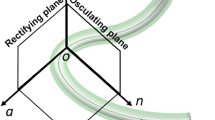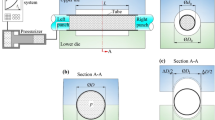Abstract
Metal tube (MT) is widely used in aerospace, marine, and vehicle fields. Springback problems on MTs during bending forming would seriously affect the forming accuracy while the springback prediction and compensation method can effectively improve the accuracy. This paper proposes a springback prediction model for variable curvature tube, which is based on the theoretical formula of the springback angle prediction of the fixed curvature tube. The curvature radius of any point on the tube central axis curve after springback can be calculated through this model. Combined with the curve Frenet formula, the functional relationship, which is between the springback of the variable curvature tube and the original parameter equation of its central axis, is established. Based on the springback prediction model, the bending compensation amount of the variable curvature tube can be obtained through the reverse process. The tube curve equation containing the compensation amount is obtained as well, which is used to compensate for the springback error of the metal tube bending forming to improve the bending forming precision. To verify the correctness of the proposed model, experiments for both fixed curvature MT and variable curvature MT were carried out. The results showed that the proposed method was good at variable curvature MT springback prediction.

















Similar content being viewed by others
Data availability
All data generated or analyzed during this study are included in this published article.
References
Al-Qureshi HA (1999) Elastic-plastic analysis of tube bending. Int J Mach Tool Manu 39(1):87–104
Zhan M, Yang H, Huang L, Gu RJ (2006) Springback analysis of numerical control bending of thin-walled tube using numerical-analytic method. J Mater Process Technol 177(1-3):197–201
E DX, Ning RX, Gu T (2009) Analysis on the elastic-plastic deformation during tube-bending process. J Ordnance Eng 30(10):1353–1356
Jia MH, Tang CT (2012) Springback prediction model on tube bending formation of stainless steel. J Beijing I Tech 9:34–38
Cleveland RM, Ghosh AK (2002) Inelastic effects on springback in metals. Int J Plast 18(5):769–785
Wang GX, Yang H, Li H, Zhan M, Gu RJ (2005) Experimental study of the influence of processing parameters on forming quality of thin-walled NC Bending Tube. Mech Sci Technol 8:117–120
Li H, Shi KP, He Y, Tian YL (2012) Springback law of thin-walled 6061-T4 Al-alloy tube upon bending. Trans Nonferrous Metal Soc 22:357–363
Wang ZK, Yang H, Li H, Ren Y, Lu RD, Tian YL (2012) Springback laws of large diameter 316 L stainless steel tube in NC bending. Mater Sci Technol 20(4):49–54
Li H, Yang H, Song FF, Zhan M, Li GJ (2012) Springback characterization and behaviors of high-strength Ti–3Al–2.5 V tube in cold rotary draw bending. J Mater Process Technol 212(9):1973–1987
Fang J, Lu S, Wang K (2018) Springback behaviors of high strength stainless steel tube after numerical control rotary draw bending. IOP Conf Ser Mater Sci Eng 423(1):012184
Xue X, Liao J, Vincze G, Gracio JJ (2015) Modelling of mandrel rotary draw bending for accurate twist springback prediction of an asymmetric thin-walled tube. J Mater Process Technol 216:405–417
Jiang ZQ, Yang H, Zhan M, Xu XD, Li GJ (2010) Coupling effects of material properties and the bending angle on the springback angle of a titanium alloy tube during numerically controlled bending. Mater Des 31(4):2001–2010
Chatti S (2010) Effect of the elasticity formulation in finite strain on springback prediction. Comput Struct 88(11-12):796–805
Li ZL (2011) NC Tube-bending forming quality analysis and numerical simulation system integration. Ph.D. Dissertation. Harbin University of Science and Technology, Dalian, China
Shahin M, Elchalakani M (2008) Neural networks for modelling ultimate pure bending of steel circular tubes. J Constr Steel Res 64(6):624–633
Liu JY, Tang CT, Ning RX (2009) The experimental study on the springback and BP NN prediction model of NC rotary-bending of tube. J Plast Eng 6:85–90
Megharbel AE, Nasser GAE, Domiaty AE (2008) Bending of tube and section made of strain-hardening materials. J Mater Process Technol 203(1-3):372–380
Xue X, Liao J, Vincze G, Pereira AB (2018) Control strategy of twist springback for aluminium alloy hybrid thin-walled tube under mandrel-rotary draw bending. Int J Mater Form 11(2):311–323
Zheng XS, Liu YL, Liu CM, Yang H (2017) Impact of springback on the cross-sectional deformation of H96 brass double-ridged rectangular tube in E-typed rotary draw bending. Int J Adv Manuf Technol 89:3451–3458
Zhu YX, Liu YL, Yang H, Li HP (2014) Impact of pressure die on springback and section deformation of rotary-draw bending of rectangular H96 tube. J Nonferrous Metal 1:104–114
Xiong H, Ma YN, Zhou SJ, He Y, Yang XE, Jin K, Wang H, Luo XY, Guo XZ (2018) Free bending forming technology of three dimensional complex axis hollow component. J Plast Eng 25(01):100–110
Guo XZ, Ma YN, Chen WL, Xiong H, Xu Y, EI-Aty AA, Jin K (2018) Simulation and experimental research of the free bending process of a spatial tube. J Mater Process Technol 255:137–149
Guo XZ, Xiong H, Xu Y, Ma YN, El-Aty AA, Tao J, Jin K (2018) Free-bending process characteristics and forming process design of copper tubular components. Int J Adv Manuf Technol 96(8):1–17
Shimada N, Tomizawa A, Kubota H, Mori H, Hara M, Kuwayama S (2014) Development of three-dimensional hot bending and direct quench technology. Procedia Eng 81:2267–2272
Vatter PH, Plettke R (2013) Process model for the design of bent 3-dimensional free-form geometries for the three-roll-push-bending process. Procedia CIRP 7(5):240–245
Chatti S, Hermes M, Tekkaya AE, Kleiner M (2010) The new TSS bending process: 3D bending of profiles with arbitrary cross-sections. CIRP Ann Manuf Technol 59(1):315–318
Gantner P, Bauer H, Harrison DK, De Silva AKM (2005) Free-Bending—a new bending technique in the hydroforming process chain. J Mater Process Technol 167(2-3):302–308
Goto H, Tanaka Y, Ichiryu K (2012) 3D tube forming and applications of a new bending machine with hydraulic parallel kinematics. Int J Autom Technol 6(4):509–515
Bini D, Jantzen RT, Merloni A (1999) Geometric interpretation of the Frenet-Serret frame description of circular orbits in stationary axisymmetric spacetimes. Classical Quant Grav 16(4):1333
Funding
This work has been funded by the National Key R&D Program of China (2018YFB1700700), the National Natural Science Foundation of China (51905476), and the Key R&D Program of Zhejiang Province (2019C05SAB51751).
Author information
Authors and Affiliations
Contributions
Shuyou Zhang’s contributions are conceptualization; funding acquisition; formal analysis; investigation; and project administration. Mengyu Fu’s contributions are formal analysis; investigation; writing—original draft; software; data curation; and visualization. Zili Wang’s contributions are funding acquisition; project administration; methodology; formal analysis; supervision; visualization; and writing—review and editing. Weimin Lin’s contributions are investigation; resources; and validation. Dingyu Fang’s contributions are investigation; resources; and validation. Huifang Zhou’s contributions are investigation and resources.
Corresponding author
Ethics declarations
Competing interests
The authors declare that they have no conflict of interest.
Ethical approval
Not applicable
Consent to participate
Not applicable
Consent to publish
The authors consent to publish this article.
Additional information
Publisher’s note
Springer Nature remains neutral with regard to jurisdictional claims in published maps and institutional affiliations.
Rights and permissions
About this article
Cite this article
Zhang, S., Fu, M., Wang, Z. et al. Springback prediction model and its compensation method for the variable curvature metal tube bending forming. Int J Adv Manuf Technol 112, 3151–3165 (2021). https://doi.org/10.1007/s00170-020-06506-0
Received:
Accepted:
Published:
Issue Date:
DOI: https://doi.org/10.1007/s00170-020-06506-0




